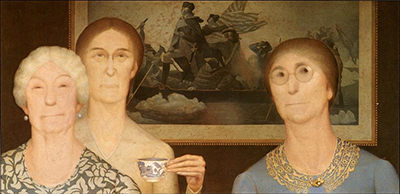Daughters of Revolution is a multi-figure portrait painting by American artist Grant Wood from 1932. At the time of this piece he would have been in his early forties and had only recently completed his iconic American Gothic.
Description
The composition features three elderly women cropped from the chest upwards. One holds a symbolic porcelain cup close to the centre of the painting, and behind them a military-based artwork hangs on the wall. Everything is tightly packed within this scene, and purposely so. Every last inch of this wide artwork is considered, with only minimal space between the ladies' heads and the side of the piece. They are also standing very close to each other, perhaps closer than they would have done on a normal social occasion. This memorable piece focuses on the relationship between these three women and also attempts to comment on their community more widely. Grant Wood titled this piece as Daughters of Revolution but described this piece as a satirical work, and perhaps was being playful with the title too, when considering the age of his subjects. The content is old fashioned in every way, from the slightly drab wall behind, to their clothing and jewellery worn by the women as the artist attempted to capture a period in time.
Painting within a Painting
The artwork seen in the background is Washington Crossing the Delaware by Emanuel Leutze from 1851. This iconic painting holds a symbolic value that was entirely relevant to the Daughters of Revolution and so was purposely chosen to sit in the background here. It features George Washington in a mythical but powerful scene and this image has appealed to many patriotic Americans ever since in was completed in the mid 19th century. The Daughters of the American Revolution (DAR) were represented within this piece and were vehemently anti-German, including against any Americans with roots in the country. Wood did not approve of their perceived bias and wanted Americans to be treated equally, regardless of their roots. The artist who produced the painting in the background actually had German roots himself, and perhaps that was the reason for why Wood playfully added it here as a means to protesting the perceived ignorance of this group, as he saw it at the time. A number of historians such as Tripp Evans and Deborah Solomon have gone into further detail about this piece, raising more questions about the identities and meaning of the three figures shown here.
Location
The painting can be found at the Cincinnati Art Museum, Cincinnati and is considered to be one of Grant Wood's most famous paintings. His two main genres could be described as portraits in this manner, where we really connect with the individual subjects, as well as open landscapes of his rural environment which have also retained a considerable popularity. The item displayed in front of us here, Daughters of the Revolution, was made using oil on masonite, just as Wood commonly worked, as it stretches to over a metre in width, whilst being around 50cm in height. It was an unusual layout for a portrait, when normally they would be taller rather than wider, but the artist regularly innovated within his work. The way in which he focuses in on the faces of these women, also allows a greater focus to fall on the painting behind too, with all other distractions left out entirely. This piece therefore offers an important contribution to the artist's career, and provides many talking points with regards the women themselves, the artist's meaning, and also the additional artwork included in the background.




